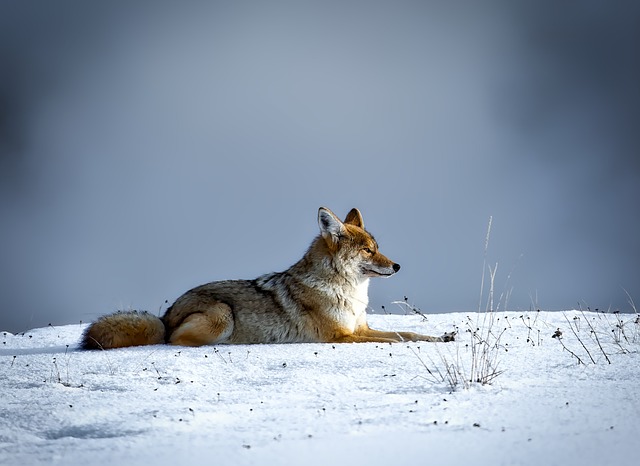Many cultures and belief systems have associated various animals with different meanings and symbolism. One such animal is the coyote, known for its cunning and adaptability. In folklore and superstition, the sighting of a coyote has been attributed with both positive and negative connotations. Whether seeing a coyote is considered good or bad luck can vary depending on cultural interpretations and personal beliefs.
Table of Contents
The Symbolism of Coyotes in Folklore and Superstitions
Coyotes have long been a subject of fascination and intrigue in folklore and superstitions. These cunning creatures have captured the imagination of people around the world, with their mysterious behavior and elusive nature. But what does it mean when you see a coyote? Is it a sign of good luck or bad luck? Let’s delve into the symbolism of coyotes in folklore and superstitions to find out.
In many Native American cultures, the coyote holds a prominent place in mythology. Often portrayed as a trickster figure, the coyote is seen as a mischievous and clever creature. It is believed that encountering a coyote can be a sign of impending change or transformation. This can be seen as both a positive and negative omen, depending on the context.
For some, seeing a coyote is seen as a warning sign. It is believed that the coyote is trying to communicate a message from the spirit world. This message could be a cautionary one, advising the individual to be cautious and vigilant in their actions. In this sense, encountering a coyote can be seen as a sign of potential danger or a need to be more aware of one’s surroundings.
On the other hand, the coyote is also associated with adaptability and resilience. These creatures have thrived in a variety of environments, from deserts to forests, showcasing their ability to adapt to different circumstances. In this light, seeing a coyote can be seen as a positive sign, indicating that the individual has the ability to navigate through challenges and come out stronger on the other side.
In some cultures, the coyote is also seen as a symbol of intelligence and resourcefulness. Their ability to outsmart their prey and survive in harsh conditions has earned them a reputation for being cunning and clever. When a coyote appears in one’s life, it may be a reminder to tap into one’s own intelligence and resourcefulness to overcome obstacles and achieve success.
Interestingly, the symbolism of coyotes in folklore and superstitions is not limited to Native American cultures. In Mexican folklore, the coyote is often associated with transformation and shapeshifting. It is believed that encountering a coyote may be a sign that one’s true nature is being revealed or that a change is on the horizon. This can be seen as a positive or negative omen, depending on one’s perspective.
In modern times, the symbolism of coyotes has also taken on new meanings. With their adaptability and ability to thrive in urban environments, coyotes have become a symbol of resilience and survival in the face of human encroachment. Seeing a coyote in a city can be seen as a reminder of the importance of coexisting with nature and finding ways to live in harmony with wildlife.
In conclusion, the symbolism of coyotes in folklore and superstitions is complex and multifaceted. While some may view seeing a coyote as a sign of good luck or bad luck, it ultimately depends on one’s interpretation and beliefs. Whether it is a warning sign or a reminder of one’s own resilience, encountering a coyote can serve as a powerful symbol in our lives. So, the next time you spot a coyote, take a moment to reflect on its significance and the messages it may be trying to convey.
Exploring the Cultural Significance of Coyotes in Native American Beliefs

Coyotes have long been a part of Native American culture, with their presence often carrying deep spiritual significance. In many Native American beliefs, the coyote is seen as a powerful and complex creature, embodying both positive and negative qualities. This has led to a wide range of interpretations regarding whether encountering a coyote is considered good or bad luck.
In some Native American tribes, the coyote is revered as a trickster figure, known for its cunning and ability to outsmart others. The coyote is seen as a teacher, imparting valuable lessons through its mischievous behavior. This perspective views encountering a coyote as a positive sign, indicating that one is about to learn an important lesson or gain new insights. It is believed that the coyote’s presence can bring about positive changes and opportunities for personal growth.
On the other hand, there are tribes that view the coyote as a symbol of chaos and disruption. They see the coyote as a bringer of bad luck, associated with deceit and unpredictability. According to this belief, encountering a coyote may indicate that one should be cautious and prepared for unexpected challenges or obstacles. It is believed that the coyote’s presence can disrupt the natural order of things and bring about negative consequences.
It is important to note that the interpretation of encountering a coyote as good or bad luck can vary greatly among different Native American tribes. Each tribe has its own unique cultural beliefs and traditions, which shape their understanding of the coyote’s significance. Therefore, it is essential to respect and honor the diversity of Native American perspectives when discussing the cultural significance of coyotes.
In addition to their spiritual significance, coyotes also play a practical role in Native American culture. They are often seen as symbols of adaptability and survival, as they are known for their ability to thrive in various environments. Native American tribes have traditionally observed the behavior of coyotes to learn survival skills and strategies. The coyote’s resourcefulness and resilience are admired and emulated, making it an important symbol in Native American folklore and storytelling.
Despite the differing interpretations of encountering a coyote, one thing remains consistent across Native American beliefs – the coyote is a creature to be respected. Whether seen as a trickster or a disruptor, the coyote is seen as a powerful and influential force in the natural world. Native American tribes have long recognized the importance of maintaining a harmonious relationship with the coyote and the natural environment.
In conclusion, the cultural significance of coyotes in Native American beliefs is a complex and multifaceted topic. While some tribes view encountering a coyote as a sign of good luck and positive change, others see it as a warning of potential challenges. Regardless of the interpretation, the coyote is universally respected as a powerful and influential creature. Its presence in Native American culture serves as a reminder of the importance of maintaining a harmonious relationship with the natural world.
Understanding the Role of Coyotes in Ecosystems and Wildlife Conservation
Coyotes are fascinating creatures that have long been a part of North American ecosystems. They are known for their adaptability and resilience, thriving in a variety of habitats from forests to deserts. However, their presence can sometimes be met with mixed feelings, with some people considering them a symbol of bad luck. But is seeing a coyote really a sign of misfortune, or is there more to these animals than meets the eye?
To understand the role of coyotes in ecosystems and wildlife conservation, it’s important to first recognize their ecological significance. Coyotes play a crucial role in maintaining the balance of nature. As opportunistic omnivores, they have a diverse diet that includes small mammals, birds, reptiles, insects, and even fruits and vegetables. By controlling populations of rodents and other small animals, coyotes help prevent outbreaks of diseases and maintain the health of ecosystems.
In addition to their role as predators, coyotes also act as scavengers, cleaning up carrion and preventing the spread of diseases. They are known to consume the remains of larger animals, such as deer, that have died from natural causes or accidents. This helps to recycle nutrients back into the ecosystem, benefiting other plants and animals.
Coyotes are also important in the context of wildlife conservation. They are considered a keystone species, meaning that their presence has a disproportionate impact on the overall structure and function of an ecosystem. Their hunting and scavenging behaviors shape the distribution and abundance of other species, influencing the dynamics of entire communities.
Despite their ecological importance, coyotes have often been misunderstood and vilified. This negative perception can be attributed to various factors, including their adaptability to human-altered landscapes and occasional conflicts with livestock and pets. However, it’s important to note that these conflicts are often a result of human activities, such as habitat destruction and the availability of food sources.
Efforts to control coyote populations through hunting and trapping have proven to be ineffective and can even lead to unintended consequences. Removing coyotes from an area can disrupt the delicate balance of ecosystems, leading to an increase in the populations of their prey species, which can in turn have negative impacts on vegetation and other wildlife.
Instead of viewing coyotes as a symbol of bad luck, it’s more productive to appreciate their role in maintaining healthy ecosystems. By understanding their behaviors and adapting our own actions, we can coexist with these remarkable animals. This includes securing garbage cans, keeping pets indoors or supervised, and avoiding feeding wildlife, which can attract coyotes and increase the likelihood of conflicts.
In conclusion, seeing a coyote should not be considered a sign of bad luck. These adaptable and resilient creatures play a vital role in ecosystems and wildlife conservation. By understanding their ecological significance and taking appropriate measures to coexist with them, we can appreciate the important role they play in maintaining the balance of nature. So, the next time you spot a coyote, consider yourself lucky to witness a fascinating part of our natural world.
Tips for Coexisting with Coyotes: Myth vs. Reality
Is seeing a coyote good or bad luck? It’s a question that has been debated for years, with many different opinions and beliefs. Some people believe that seeing a coyote is a sign of good luck, while others believe it is a sign of bad luck. But what is the truth? In this article, we will explore the myth versus reality of coexisting with coyotes and provide some tips for living harmoniously with these fascinating creatures.
Let’s start by debunking the myth that seeing a coyote is a sign of bad luck. Coyotes are highly adaptable animals that have managed to thrive in a variety of environments, including urban areas. They are intelligent and resourceful, and their presence should be seen as a testament to their ability to survive and adapt. In fact, many Native American cultures view the coyote as a symbol of intelligence, adaptability, and survival. So, if you happen to see a coyote, consider yourself lucky to witness such a remarkable creature in its natural habitat.
Now, let’s address the reality of coexisting with coyotes. While coyotes are generally not a threat to humans, it is important to take precautions to ensure the safety of both yourself and the coyotes. One of the most important things to remember is to never feed coyotes. Feeding them can lead to habituation, where they become dependent on human food sources and lose their fear of humans. This can lead to more frequent encounters and potentially dangerous situations. So, always keep your distance and never attempt to feed or approach a coyote.
Another reality of coexisting with coyotes is the importance of securing your garbage and pet food. Coyotes are opportunistic scavengers and will take advantage of any easy food source. Make sure your garbage cans are securely closed and stored in a location that is not easily accessible to coyotes. Additionally, if you have outdoor pets, be sure to bring their food inside at night to avoid attracting coyotes to your property.
It is also important to keep in mind that coyotes are territorial animals. They mark their territory with urine and feces, and they may vocalize to communicate with other coyotes in the area. If you hear a coyote howling or yipping, it is simply their way of communicating and should not be cause for alarm. However, if you have small children or pets, it is a good idea to supervise them when they are outside, especially during dawn and dusk when coyotes are most active.
Lastly, it is important to remember that coyotes play a vital role in the ecosystem. They help control populations of rodents and other small mammals, which can help prevent the spread of disease. By coexisting with coyotes and respecting their presence, we can help maintain a healthy balance in our environment.
In conclusion, seeing a coyote is neither good nor bad luck. It is simply an opportunity to witness a remarkable creature in its natural habitat. By understanding the reality of coexisting with coyotes and taking necessary precautions, we can live harmoniously with these fascinating animals. So, the next time you see a coyote, take a moment to appreciate its beauty and resilience, and remember to respect its space.
Conclusion
Seeing a coyote is neither inherently good nor bad luck.
For licensing reasons, we must provide the following notice: This content was created in part with the help of an AI.


